473-6251, Songwriters Call Home
The other day a student wanted to know how to write a song? That's easy, I
replied. Just apply your TALENT and CREATIVITY to the Circle of Fifths - 4736251.
You can't help but write a song and you might even write a HIT SONG!
Now, just what is the "circle of fifths"? Once again, we'll begin with the "oldies".
When Pythagoras discovered the "Perfect" 4th and 5th intervals he made it possible for us to locate the same letter, from any starting letter, by moving either "up" toward the bridge (higher in pitch) or "down" toward the nut (lower in pitch). For example, to arrive at tone 4 from tone 1 (Root) we may either "move up a perfect 4th" ( 5 frets) or "move down a perfect 5th" (7 frets). The C Major Scale is illustrated as letters and tones on the 6th string in Figure 1.
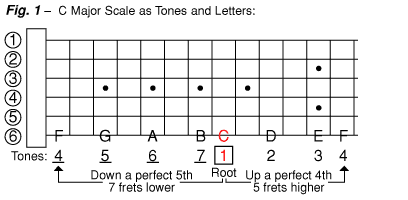
By applying this "down a 5th" principle we can arrange the 12 tones of Music "clock-wise" around a circle. The "Circle of 5ths" is shown in Figure 2.
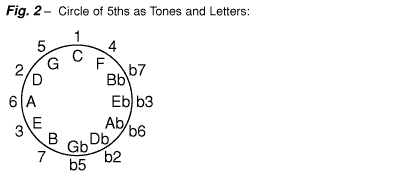
As we learned previously, by selecting every other tone or letter of the major scale, 7 chords may be "spelled". Lets illustrate the C major scale as tones (Arabic numbers), letters and 7 chord triads (Roman Numerals). See Figure 3.

If we select only the 7 tones, letters and chord triads of the C major scale, in the Circle of 5ths order, we notice a "re-arrangement" of the tones: 4736251, letters: FBEADGC and chords: IV viib5 iii vi ii V I. See figure 4.
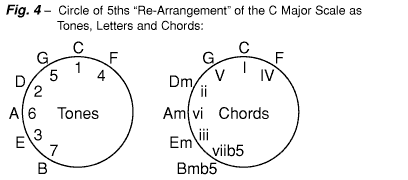
Now, when we arrange these 7 chords equal-distant around a circle, and draw lines to connect them in the circle of 5ths order - the Songwriters 7 pointed star is revealed! See figure 5.
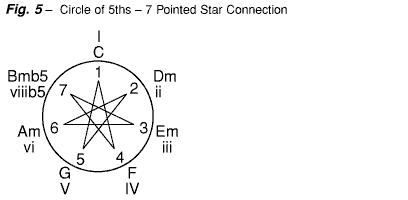
Of course you may play any combination of chords you wish. However, a vast majority of chord progressions follow the circle of 5ths order. Let's explore a few of the virtually infinite number of possible combinations (chord progressions). See Figures 6 through 14.
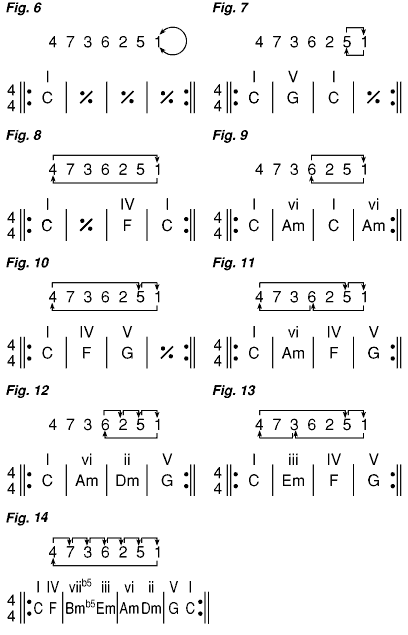
Did someone say - Fretboard Flashcards?
And till next time, have some fun writing those hits! I'll be listening...
Return to Advanced Lessons
Now, just what is the "circle of fifths"? Once again, we'll begin with the "oldies".
When Pythagoras discovered the "Perfect" 4th and 5th intervals he made it possible for us to locate the same letter, from any starting letter, by moving either "up" toward the bridge (higher in pitch) or "down" toward the nut (lower in pitch). For example, to arrive at tone 4 from tone 1 (Root) we may either "move up a perfect 4th" ( 5 frets) or "move down a perfect 5th" (7 frets). The C Major Scale is illustrated as letters and tones on the 6th string in Figure 1.

By applying this "down a 5th" principle we can arrange the 12 tones of Music "clock-wise" around a circle. The "Circle of 5ths" is shown in Figure 2.

As we learned previously, by selecting every other tone or letter of the major scale, 7 chords may be "spelled". Lets illustrate the C major scale as tones (Arabic numbers), letters and 7 chord triads (Roman Numerals). See Figure 3.

If we select only the 7 tones, letters and chord triads of the C major scale, in the Circle of 5ths order, we notice a "re-arrangement" of the tones: 4736251, letters: FBEADGC and chords: IV viib5 iii vi ii V I. See figure 4.

Now, when we arrange these 7 chords equal-distant around a circle, and draw lines to connect them in the circle of 5ths order - the Songwriters 7 pointed star is revealed! See figure 5.

Of course you may play any combination of chords you wish. However, a vast majority of chord progressions follow the circle of 5ths order. Let's explore a few of the virtually infinite number of possible combinations (chord progressions). See Figures 6 through 14.

Did someone say - Fretboard Flashcards?
And till next time, have some fun writing those hits! I'll be listening...